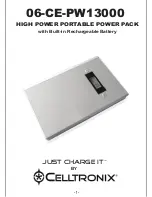
10
www.comcoinc.com
Troubleshooting
If the unit does not pressurize when you turn it on:
•
Is there power to the unit? Does the light on the power switch illuminate?
If not, check the power cord connections at the back of the unit and at the power source. Check the fuse.
•
Is the air line connected? Are the upstream valves open?
Check the inlet air supply.
•
Do you hear air escaping from the unit when it is turned on?
Check that the inlet air, vent hose, and abrasive hose exiting the PowderGate® valve are connected properly.
See the set‐up guide on pages 4 and 5. Make sure the tank cover is securely fastened.
If you are getting air through the nozzle, but no abrasive; or if the cutting action decreases:
•
Is the powder tank empty?
Refill.
•
Is the abrasive in the tank damp and sticking to the walls?
Replace with fresh powder. Check that your air dryer is working properly.
•
Is the tank orifice plugged?
Empty powder, remove orifice, and inspect. Check to see if your supplier of abrasive powder is providing high
quality material. For details see the Support section on our website.
•
Is the modulator functioning properly?
You should hear a buzzing sound when the blast is activated. If not, the modulator may need to be replaced.
For further details contact Technical Support.
If nothing happens when the blast is activated:
•
Is the nozzle plugged?
Remove and inspect.
•
Is the PowderGate® valve failing to open?
Contact Technical Support.
If you suspect the PowderGate® valve is not closing completely:
When the PowderGate® valve closes, place a finger over the end of the nozzle for 3 seconds. When you remove
your finger– is there a small puff of air? If so, there are two possibilities:
•
The PowderGate® nose is worn and can be replaced as described above.
•
The abrasive mixture may be too rich. Reduce Abrasive Blend adjustment on front panel, or check the Bypass
Tube Chart for a leaner mixture to handle your nozzle size.
Prevent Moisture and Oil Contamination
Contamination of the abrasive powder from moisture and/or oil is one of the most common problems
associated with micro‐abrasive blasting. Moisture will cause the powder to “clump up,” preventing it from
flowing freely from the tank.
Moisture will cause the powder to "clump up" preventing it from flowing freely from the tank.
Oil in the air supply will not only affect abrasive flow, it can also cause major component failures within your
blaster, resulting in costly repairs.
To avoid moisture and oil contamination, run your air supply through a positive air dryer equipped with an
appropriate oil filter.
































